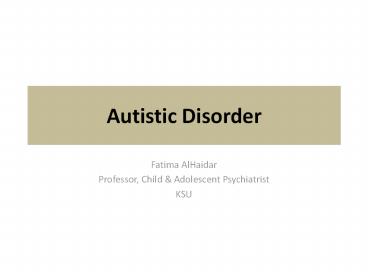Autistic Disorder - PowerPoint PPT Presentation
Title:
Autistic Disorder
Description:
Autistic Disorder Fatima AlHaidar Professor, Child & Adolescent Psychiatrist KSU Definition: Childhood autism is one of the PDDs that is characterized by early onset ... – PowerPoint PPT presentation
Number of Views:112
Avg rating:3.0/5.0
Title: Autistic Disorder
1
Autistic Disorder
- Fatima AlHaidar
- Professor, Child Adolescent Psychiatrist
- KSU
2
Definition
- Childhood autism is one of the PDDs that is
characterized by early onset (before 3 years of
age) of delay and deviation in three critical
areas of development - 1- the ability to form social relationships and
to share interest and emotions. - 2- the use of language and communication ( both
verbal and non-verbal) . - 3- the presence of severely incapacitating
ritualistic tendencies .
3
Clinical Picture
- A. Behavioral Features,
- 1- social relationships.
- 2- speech and language development.
- 3- mannerisms.
- 4- resistance to change.
- 5- attachment to particular objects.
- 6- acute emotional reactions.
- 7- other behavioral symptoms.
4
Clinical Picture cont.
- B. Intellectual development,
- 1- general intelligence.
- 2- specific deficit.
- 3- special abilities.
- C. Physical conditions
5
Background Factors
- 1- Overview.
- 2- Genetic factors.
- 3- Underlying physical conditions.
- 4- Parents and family factors.
- 5- Link with schizophrenia.
6
ASSESSMENT
- 1- Overview.
- 2- Differential diagnoses
- 1- MR and learning disabilities.
- 2- Aspergers disorder.
- 3- Childhood disintegrative disorder.
- 4- Retts disorder.
- 5- Language developmental disorders.
- 6- Childhood schizophrenia.
- 7- ADHD
- 8- Attachment disorders.
7
Management
- Explain to the parents the nature of the
diagnosis and its probable cause and the way the
child can be helped and the likely outcome. - Neither medications nor interpretive form of
psychotherapy directed to the patient have a
significant place in management. - Behavioral and educational methods have been
shown to be helpful.
8
Management cont.
- Goals for treatment
- 1- fostering of normal development
- - parental counseling
- - behavioral methods
- - special schooling.
- 2- reduction of rigidity and stereotypy.
- 3- removal of maladaptive behavior.
- 4- alleviation of family distress.
9
Outcome
- A life-long condition
- - 66 ---- total dependence.
- - 50 ---- linguistic impairment.
- - 10 ---- slight improvement.
- - lt10 ----working.
- - 16 ----epilepsy.
- - 50---- deterioration during adolescence.
- - 10 ---- psychiatric disturbance.
- Important factors relevant to outcome
- - IQ
- - quality of parental care and education.
- - slow progress.































